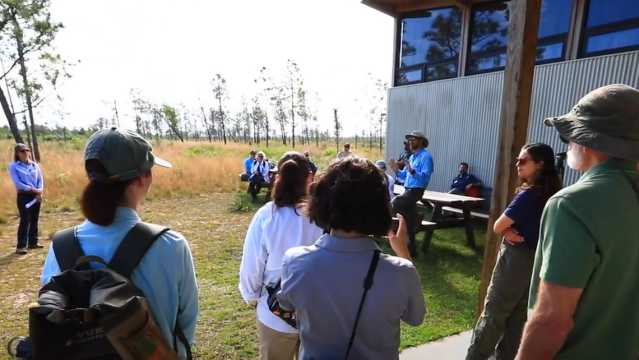Wildlife researchers ventured through the dense grass of north Florida, undaunted by the presence of the formidable “apex predator” species they held in their hands.
On April 30, these researchers converged at the Apalachicola Bluffs and Ravines Preserve with a mission: to reintroduce 41 of these creatures back into their natural habitat.
These creatures are eastern indigo snakes, known as the longest snake species in the U.S., and they serve a crucial role in the local ecosystem, as highlighted by James Bogan Jr., the director of Central Florida Zoo’s Orianne Center for Indigo Conservation.
Bogan expressed a sense of pride at the eighth annual reintroduction effort, marking the highest number of releases in a single year thus far, as stated in a news release from the Central Florida Zoo.
“It is heartening to witness these young indigos reclaiming their significant role as a keystone species in the longleaf pine ecosystem,” remarked Bogan.
Eastern indigo snakes are instrumental in maintaining balance within the now rare ecosystem, preying on both venomous and nonvenomous snakes, as well as other wildlife. While native to the southeast U.S., their population has dwindled due to habitat loss.
Having disappeared from the Apalachicola Bluffs and Ravines Preserve since 1982, scientists have undertaken reintroduction efforts since 2017, aiming to bolster both the snake species and the ecosystem.
While the Central Florida Zoo bred the 2-year-old snakes for release, a significant breakthrough occurred in 2023 when wild eastern indigo snakes, not bred by the zoo, were discovered.
“This year holds special significance because we actually found two hatchlings on the preserve during the last survey season,” shared Michelle Hoffman, a field biologist with the Orianne Center for Indigo Conservation. “It’s truly encouraging to witness the snakes not only surviving but also reproducing successfully.”
Eastern indigo snakes typically measure between 5 to 7 feet in length, but they can grow to over 8 feet, making them the longest snake species indigenous to North America.
To date, 167 snakes have been reintroduced into the preserve, marking a significant milestone for conservationists involved in the long-term initiative.
Michele Elmore, a U.S. Fish and Wildlife Service recovery biologist for the eastern indigo snake, expressed optimism about the progress of the program. “The indigo is making strides in returning to its rightful place in the landscape,” she affirmed.
Situated in the Florida Panhandle, approximately 45 miles west of Tallahassee, the Apalachicola Bluffs and Ravines Preserve serves as a crucial sanctuary for these majestic creatures.















































